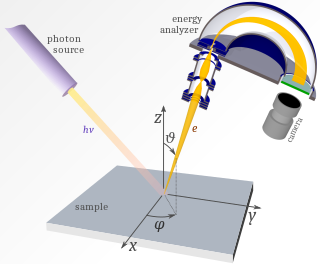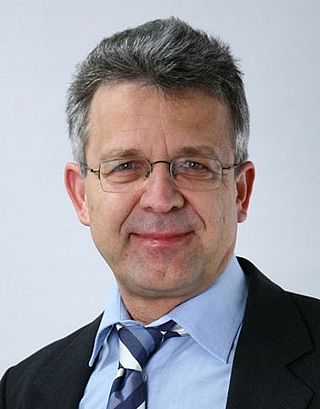Related Research Articles

Condensed matter physics is the field of physics that deals with the macroscopic and microscopic physical properties of matter, especially the solid and liquid phases, that arise from electromagnetic forces between atoms and electrons. More generally, the subject deals with condensed phases of matter: systems of many constituents with strong interactions among them. More exotic condensed phases include the superconducting phase exhibited by certain materials at extremely low cryogenic temperatures, the ferromagnetic and antiferromagnetic phases of spins on crystal lattices of atoms, the Bose–Einstein condensates found in ultracold atomic systems, and liquid crystals. Condensed matter physicists seek to understand the behavior of these phases by experiments to measure various material properties, and by applying the physical laws of quantum mechanics, electromagnetism, statistical mechanics, and other physics theories to develop mathematical models and predict the properties of extremely large groups of atoms.
Solid-state physics is the study of rigid matter, or solids, through methods such as solid-state chemistry, quantum mechanics, crystallography, electromagnetism, and metallurgy. It is the largest branch of condensed matter physics. Solid-state physics studies how the large-scale properties of solid materials result from their atomic-scale properties. Thus, solid-state physics forms a theoretical basis of materials science. Along with solid-state chemistry, it also has direct applications in the technology of transistors and semiconductors.

Computational physics is the study and implementation of numerical analysis to solve problems in physics. Historically, computational physics was the first application of modern computers in science, and is now a subset of computational science. It is sometimes regarded as a subdiscipline of theoretical physics, but others consider it an intermediate branch between theoretical and experimental physics — an area of study which supplements both theory and experiment.
In astrophysics and condensed matter physics, electron degeneracy pressure is a quantum mechanical effect critical to understanding the stability of white dwarf stars and metal solids. It is a manifestation of the more general phenomenon of quantum degeneracy pressure.

Photoemission spectroscopy (PES), also known as photoelectron spectroscopy, refers to energy measurement of electrons emitted from solids, gases or liquids by the photoelectric effect, in order to determine the binding energies of electrons in the substance. The term refers to various techniques, depending on whether the ionization energy is provided by X-ray, XUV or UV photons. Regardless of the incident photon beam, however, all photoelectron spectroscopy revolves around the general theme of surface analysis by measuring the ejected electrons.
In condensed matter physics, a quasiparticle is a concept used to describe a collective behavior of a group of particles that can be treated as if they were a single particle. Formally, quasiparticles and collective excitations are closely related phenomena that arise when a microscopically complicated system such as a solid behaves as if it contained different weakly interacting particles in vacuum.
In solid-state physics, the electronic band structure of a solid describes the range of energy levels that electrons may have within it, as well as the ranges of energy that they may not have.
In quantum field theory, the energy that a particle has as a result of changes that it causes in its environment defines self-energy, and represents the contribution to the particle's energy, or effective mass, due to interactions between the particle and its environment. In electrostatics, the energy required to assemble the charge distribution takes the form of self-energy by bringing in the constituent charges from infinity, where the electric force goes to zero. In a condensed matter context, self-energy is used to describe interaction induced renormalization of quasiparticle mass (dispersions) and lifetime. Self-energy is especially used to describe electron-electron interactions in Fermi liquids. Another example of self-energy is found in the context of phonon softening due to electron-phonon coupling.

Angle-resolved photoemission spectroscopy (ARPES) is an experimental technique used in condensed matter physics to probe the allowed energies and momenta of the electrons in a material, usually a crystalline solid. It is based on the photoelectric effect, in which an incoming photon of sufficient energy ejects an electron from the surface of a material. By directly measuring the kinetic energy and emission angle distributions of the emitted photoelectrons, the technique can map the electronic band structure and Fermi surfaces. ARPES is best suited for the study of one- or two-dimensional materials. It has been used by physicists to investigate high-temperature superconductors, graphene, topological materials, quantum well states, and materials exhibiting charge density waves.
The GW approximation (GWA) is an approximation made in order to calculate the self-energy of a many-body system of electrons. The approximation is that the expansion of the self-energy Σ in terms of the single particle Green's function G and the screened Coulomb interaction W

Alexander Leonidovich Kuzemsky is a Russian theoretical physicist.
The coherent potential approximation (CPA) is a method, in theoretical physics, of finding the averaged Green's function of an inhomogeneous system. The Green's function obtained via the CPA then describes an effective medium whose scattering properties represent the averaged scattering properties of the disordered system being approximated. It is often described as the 'best' single-site theory for obtaining the averaged Green's function. It is perhaps most famous for its use in describing the physical properties of alloys and disordered magnetic systems, although it is also a useful concept in understanding how sound waves scatter in a material which displays spatial inhomogeneity. The coherent potential approximation was first described by Paul Soven, and its application in the context of calculations of the electronic structure of materials was pioneered by Balász Győrffy.
The Korringa–Kohn–Rostoker (KKR) method is used to calculate the electronic band structure of periodic solids. In the derivation of the method using multiple scattering theory by Jan Korringa and the derivation based on the Kohn and Rostoker variational method, the muffin-tin approximation was used. Later calculations are done with full potentials having no shape restrictions.
Yambo is a computer software package for studying many-body theory aspects of solids and molecule systems. It calculates the excited state properties of physical systems from first principles, e.g., from quantum mechanics law without the use of empirical data. It is an open-source software released under the GNU General Public License (GPL). However the main development repository is private and only a subset of the features available in the private repository are cloned into the public repository and thus distributed.
In physics, the plasmaron was proposed by Lundqvist in 1967 as a quasiparticle arising in a system that has strong plasmon-electron interactions. In the original work, the plasmaron was proposed to describe a secondary peak in the photoemission spectral function of the electron gas. More precisely it was defined as an additional zero of the quasi-particle equation . The same authors pointed out, in a subsequent work, that this extra solution might be an artifact of the used approximations:
We want to stress again that the discussion we have given of the one-electron spectrum is based on the assumption that vertex corrections are small. As discussed in the next section recent work by Langreth [29] shows that vertex corrections in the core electron problem can have a quite large effect on the form of satellite structures, while their effect on the quasi particle properties seems to be small. Preliminary investigations by one of us (L.H.) show similar strong vertex effects on the conduction band satellite. The details of the plasmaron structure should thus not be taken very seriously.

Martin Aeschlimann is a Swiss physicist and professor in the physics department of the University of Kaiserslautern. Since 2008 he is the spokesman of the State Research Center for Optics and Material Sciences (OPTIMAS).

Pedro Miguel Etxenike Landiribar, also known as Pedro Miguel Echenique, is a Basque theoretical solid-state physicist, Professor of Condensed Matter Physics at the University of the Basque Country (UPV/EHU), and former minister of the Basque Autonomous Community.

Jan Korringa was a Dutch American theoretical physicist, specializing in theoretical condensed matter physics. He also contributed to the KKR Method.
The linearized augmented-plane-wave method (LAPW) is an implementation of Kohn-Sham density functional theory (DFT) adapted to periodic materials. It typically goes along with the treatment of both valence and core electrons on the same footing in the context of DFT and the treatment of the full potential and charge density without any shape approximation. This is often referred to as the all-electron full-potential linearized augmented-plane-wave method (FLAPW). It does not rely on the pseudopotential approximation and employs a systematically extendable basis set. These features make it one of the most precise implementations of DFT, applicable to all crystalline materials, regardless of their chemical composition. It can be used as a reference for evaluating other approaches.
Stefan Hüfner was a German experimental physicist specialized in solid-state physics and photoemission spectroscopy.
References
- 1 2 3 4 5 6 7 Rehr, J J (2005-01-01). "Lars Hedin and the quest for a theory of excited states". Physica Scripta. T115: 19–23. doi:10.1088/0031-8949/2005/T115/001. ISSN 0031-8949.
- 1 2 3 4 5 6 7 8 9 10 11 12 Almbladh, Carl-Olof; von Barth, Ulf (2016). "Lars Hedin and the theory of solid state physics" (PDF). In Forkman, Bengt; Holmin Verdozzi, Kristina (eds.). Physics in Lund - in time and space. Translated by Sheppard, Helen. Lund University, Department of Physics. pp. 246–261.
- 1 2 3 4 5 Schattke, Wolfgang; Hove, Michel A. Van (2003-11-21). "In memoriam Lars Hedin (1930–2002)". Solid-State Photoemission and Related Methods: Theory and Experiment. John Wiley & Sons. p. VII. ISBN 978-3-527-40334-9.
- ↑ Hedin, Lars (1965). "New Method for Calculating the One-Particle Green's Function with Application to the Electron-Gas Problem". Physical Review. 139 (3A): A796–A823. Bibcode:1965PhRv..139..796H. doi:10.1103/PhysRev.139.A796.
- 1 2 Aryasetiawan, F; Gunnarsson, O (1998-03-01). "The GW method". Reports on Progress in Physics. 61 (3): 237–312. arXiv: cond-mat/9712013 . doi:10.1088/0034-4885/61/3/002. ISSN 0034-4885.
- 1 2 3 4 Hedin, Lars; Lundqvist, Stig (1970), "Effects of Electron-Electron and Electron-Phonon Interactions on the One-Electron States of Solids", Solid State Physics, vol. 23, Elsevier, pp. 1–181, doi:10.1016/s0081-1947(08)60615-3, ISBN 978-0-12-607723-0 , retrieved 2024-12-06
- ↑ Scheffler, Matthias; Weinberger, Peter (2011-06-28). Walter Kohn: Personal Stories and Anecdotes Told by Friends and Collaborators. Springer Science & Business Media. ISBN 978-3-642-55609-8.